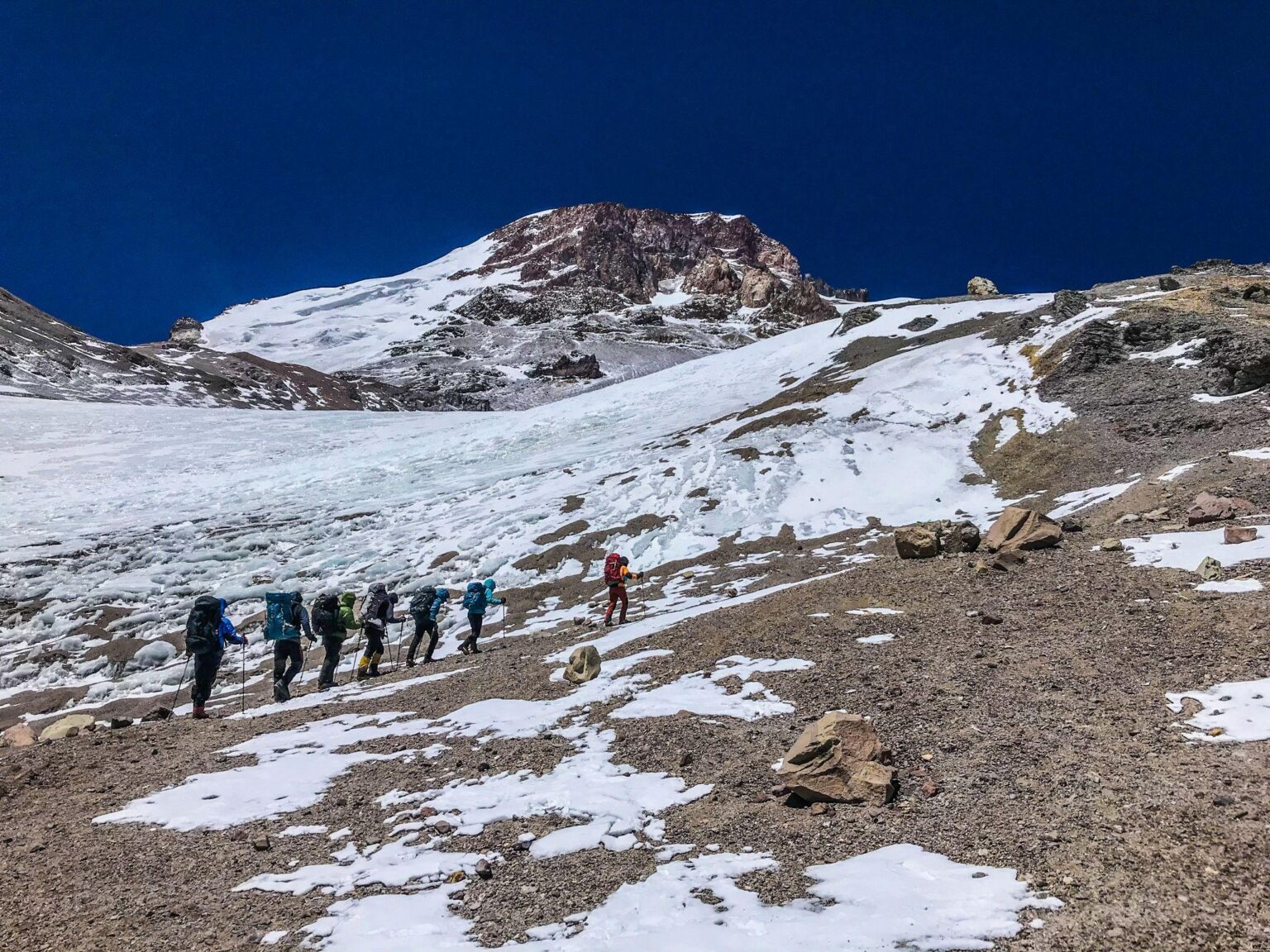What Makes Aconcagua Unique
Aconcagua offers several established routes—most notably the Normal Route via Plaza de Mulas and the 360 Route via Plaza Argentina. The former is shorter and more direct, while the latter provides better acclimatization through a longer, more scenic approach.
Despite its lack of technical climbing on the normal routes, the mountain is still a major challenge. Conditions can rapidly shift, with freezing temperatures, strong Pacific winds, and high-altitude exposure making it one of the most physically and mentally demanding Seven Summits. High camp temperatures can drop to –30°C (–22°F), with wind chill plunging temperatures below –50°C (–58°F).
As one of the Seven Summits, this mountain is a significant step forward in your climbing and mountaineering progression. It allows you to experience the kind of altitude you’ll need to reach without supplemental oxygen when tackling 7000–8000m (23,000-26,000ft) peaks.
Physical Demands
The primary physical demands of Aconcagua include:
- Heavy load carrying across scree and unstable terrain while wearing heavy boots and gear
- High altitude and cold exposure will impact movement, sleep, appetite, and recovery
- Sleep and recovery disruptions
- Cumulative fatigue from multiple days of effort
These stressors compound over back-to-back days, culminating in a summit push with 1,000–1,500 m (3,280-4,900ft) of vertical gain— followed by a grueling descent on exhausted legs.
How to Train for Aconcagua
The foundation is the same as for all big mountain objectives: a long-term commitment to structured endurance training. Here’s how I break it down when coaching Uphill Athletes.
- Aerobic Base Development
Building aerobic efficiency is the single most important factor. High altitude demands long durations of low-intensity output, where anaerobic metabolism is counterproductive and unsustainable. Training must start months in advance—ideally 6 to 9 months—for adaptations to take place. Read more about aerobic training >> - Strength and Muscular Endurance
Strength development progresses from general strength to max strength to specific muscular endurance—especially relevant for carrying loads at altitude. This also includes targeted work for core stability and balance (knees, hips, spine). Learn more about our strength training philosophy >> - Fatigue Resistance & Training Density
Structured back-to-back long Zone 2 sessions (often on weekends) simulate the cumulative fatigue experienced on multi-day ascents. Balancing these with rest days and recovery workouts helps develop “durability.” - Adaptation to Stress
Overall stress must be factored into the training plan. Athletes balancing work and family life require individualized programming that respects their bandwidth. Smart planning of training density (distribution of intensity and duration) prevents overtraining and burnout. - Internal Monitoring & Self-Awareness
While wearable data (heart rate, HRV, etc.) is helpful, subjective feedback remains highly relevant. Athletes must learn to read their bodies and self-assess—particularly when external data becomes unreliable due to dehydration, sleep loss, or altitude. - Acclimatization Strategies
Time under hypoxia is the most critical variable in acclimatization. Most Aconcagua expeditions take 2–3 weeks on the mountain, with a permit-enforced 20-day limit. Proper acclimatization involves slow, steady ascents, rest days, and carries to higher camps before sleeping low.
For those with limited time, pre-acclimatization protocols using hypoxic tents or active hypoxic training can simulate altitude adaptation at home. However, these methods require expert guidance to be effective—doses must be personalized, monitored, and strategically timed. Read more: What we know and what we don’t know about Xenon gas >>
Hypoxic Conditioning Coaching
Common Mistakes to Avoid
- Underestimating the climb: Non-technical doesn’t mean easy. Altitude, cold, wind, and logistics make it one of the most physically draining Seven Summits.
- Inadequate preparation time: True aerobic adaptations take months, not weeks. There are no shortcuts to building fitness, so start at least 6 months out from departure.
- Skipping strength and loaded pack training: Most climbers will carry their own gear to high camps. Not training for this can result in exhaustion—and failure.
- Neglecting descent fitness: Many accidents happen during descent, when energy is low and coordination is impaired. Leg soreness from a long downhill requires more recovery at higher elevations.
- Disregarding pacing: Heart rate data becomes unreliable above base camp; climbers must rely on feel and experience to avoid overexertion.
The Role of Mental Preparation
Final Thoughts - Why Aconcagua is Worth It
I climbed Aconcagua 3 times in December 2019. One of those ascents was a speed climb from Plaza de Mulas to the summit in just 3 hours and 38 minutes—a new record at the time. I had the opportunity to climb the mountain via 2 different routes. It is an extremely challenging but beautiful climb and a true test of your preparation.
The high altitude and cold weather exposes weaknesses in fitness, logistics, and mindset. But with smart, structured training and a willingness to learn from the mountain, it can be a formative and empowering experience—both for aspiring mountaineers and seasoned expeditioners alike. For many, this is a stepping stone to Denali, Everest, or technical climbs in the Greater Ranges.
Despite the hard work it takes to prepare and climb the mountain, you’ll experience a summit view that stretches over the Andes and deep into the soul. It’s worth it.

